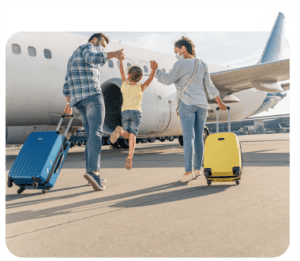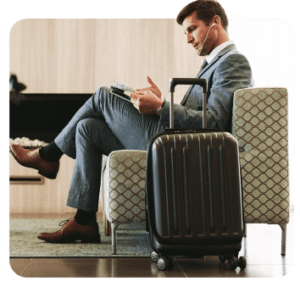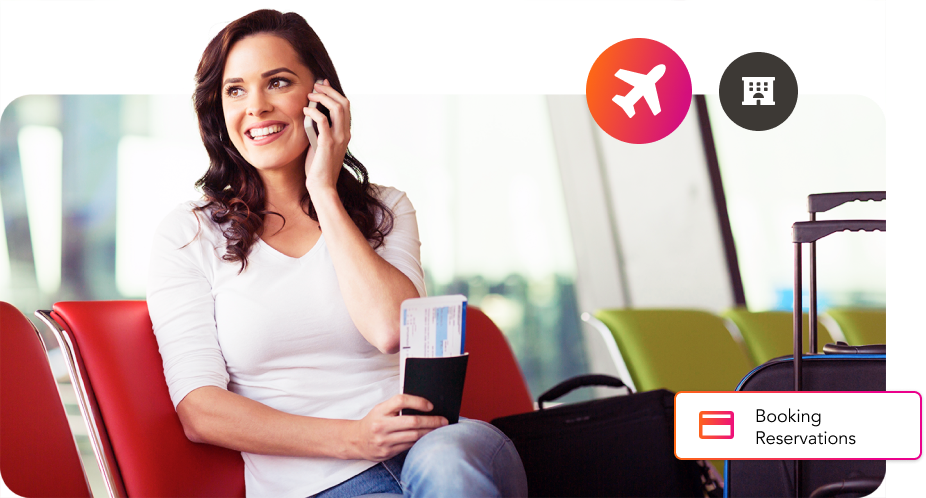In our recent joint webinar, Business or Leisure? How to Use AI & Automation to Better Understand Your Traveler, Uniphore and DataArt explored how today’s AI technology is transforming the travel and hospitality customer experience. If you couldn’t attend (or just want a recap), don’t worry—we have you covered. Below are the top seven takeaways from our panel of travel and hospitality experts.
Air travel is up in Europe and the Americas, down in Asia and the South Pacific
 While air travel slowed to a trickle in the immediate wake of the 2020 pandemic, today’s picture is considerably rosier. As more and more countries lift travel restrictions, air traffic in many areas is climbing back to pre-pandemic levels. However, the recovery has been somewhat lopsided. While North American, South American and European air travel continues to trend upward—with spikes in flights from the U.S. to Canada, Mexico and Latin America—travel to Asia, Australia and New Zealand lags considerably. According to John Heimlich, VP and Chief Economist at Airlines for America, flights from the U.S. to Hong Kong, Japan and South Korea are down 98 percent, 78 percent and 67 percent, respectively, for the month of April, largely due to ongoing restrictions.
While air travel slowed to a trickle in the immediate wake of the 2020 pandemic, today’s picture is considerably rosier. As more and more countries lift travel restrictions, air traffic in many areas is climbing back to pre-pandemic levels. However, the recovery has been somewhat lopsided. While North American, South American and European air travel continues to trend upward—with spikes in flights from the U.S. to Canada, Mexico and Latin America—travel to Asia, Australia and New Zealand lags considerably. According to John Heimlich, VP and Chief Economist at Airlines for America, flights from the U.S. to Hong Kong, Japan and South Korea are down 98 percent, 78 percent and 67 percent, respectively, for the month of April, largely due to ongoing restrictions.
Leisure travel leads the way
After two years of restrictions, demand for travel services—particularly for leisure—is higher than ever. However, with more companies shifting to remote interactions and limiting employee travel, business travel remains weak.
“We have strong traffic demand, particularly with respect to leisure and visiting friends and relatives. Where we're lagging [is with] large corporations that plateaued a bit at 30 percent below ticket sales pre-pandemic.”
John Heimlich, VP and Chief Economist at Airlines for America
Also putting downward pressure on corporate travel are companies delaying the return to the office in response to recent outbreaks, like those seen with the Omicron variant. “We find generally a high correlation between return to office and return to the skies.”
Business travel looks different today


Gianna Rivera, Travel Distribution Consultant and former GVP at Wyndham, agrees. Looking at hotel and airline trends, she’s noticed a blurring between business and leisure travel behavior and expectations. More corporate travelers are booking trips not only for themselves but also for family members and guests. Meanwhile, hotels are responding to an increased demand for business amenities, like additional outlets for laptops, quiet areas for business calls and expanded menu options for hotel-bound workers. “From a hotel perspective, what changes is how the hotel lays out everything from its lobby to the types of services it offers,” she explains. “You may have where [a group] gets to the destination, and then the corporate traveler has to do some business while the family decides to go off and do something for the day.”
New opportunities abound
With the blurring of business and leisure travel comes new opportunities for hospitality providers to create a differentiated experience that caters to both. From physical amenities—like lockers that allow business travelers to store laptops, etc. in the lobby while not working—to digital service improvements that make it easier to book business and leisure trips together, travel service providers that adapt to the shifting norm can quickly gain a competitive advantage over their peers. However, identifying and implementing the right mix of “business-leisure” amenities and services (while simultaneously controlling costs) requires a better understanding of today’s traveler profile.


It’s time to rethink the business traveler profile
The rise of business-leisure travel poses a challenge to traditional booking and lodging services, which typically offer separate experiences, rewards, etc. for corporate travelers and those traveling exclusively for pleasure. “Clearly, we simply can’t rely on the algorithms of the past and the mix of corporate versus leisure agent bookings to try to understand the customer,” Rivera states. “Here is where AI can help companies, specifically in travel and hospitality, have better conversations with their customers.”
By applying artificial intelligence across every customer service channel, travel organizations can identify business-leisure travelers and create a curated experience tailored to their unique needs. For example, when asked if a customer is traveling alone are traveling alone or with guests, their response can be used to refine their experience. For business-leisure travelers, this could include suggesting more family-friendly lodging, joint room options or hotels with a higher density of family restaurants nearby. This data can also help agents better navigate customer service requests that blend corporate and leisure travel needs.
“Clearly, we simply can't rely on the algorithms of the past and the mix of corporate versus leisure agent bookings to try to understand the customer. Here is where AI can help companies, specifically in travel and hospitality, have better conversations with their customers.” ”
Gianna Rivera, Travel Distribution Consultant and former GVP at Wyndham
AI can optimize CX across multiple channels and platforms…


And the possibilities for AI aren’t limited to the point of sale either. By better identifying the traveler profile, AI can even help automate other hospitality-related tasks, like assigning extra room keys to corporate travelers traveling with family members and predicting additional staffing needs.
…and help customer service agents perform better
As mentioned before, AI can help customer service agents navigate blended business-leisure requests. CX platforms that leverage conversational AI technology can capture and surface relevant data, suggest next-best actions and even detect a customer’s emotional state—all during a live interaction. This dynamic, real-time approach to data allows agents to respond to customer requests with greater agility, effectiveness and even empathy. Taken together, these factors are proven to improve customer satisfaction and loyalty as well as operational efficiency.
